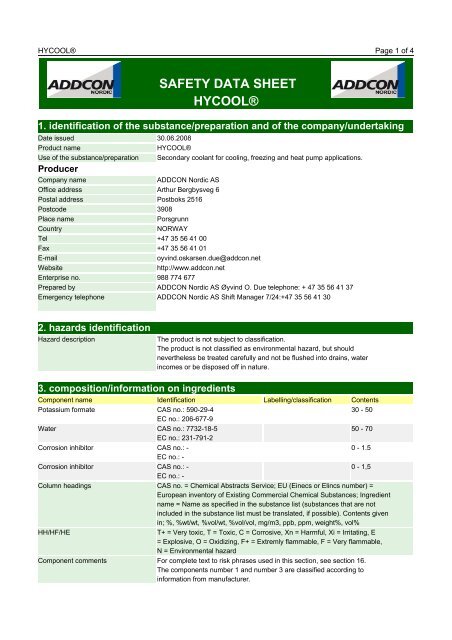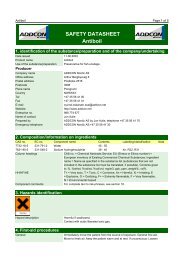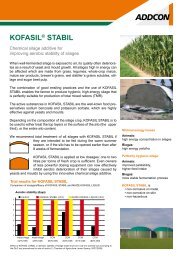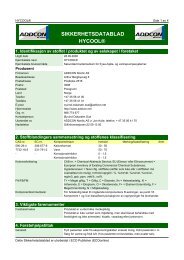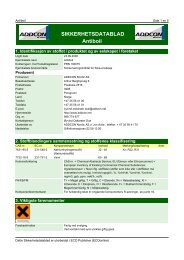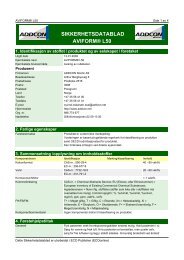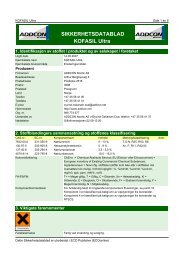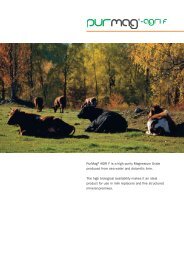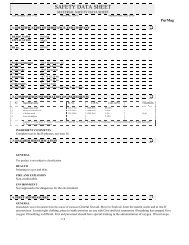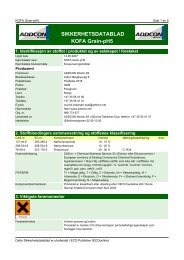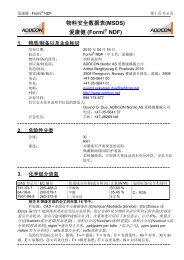SAFETY DATA SHEET HYCOOL® - Addcon
SAFETY DATA SHEET HYCOOL® - Addcon
SAFETY DATA SHEET HYCOOL® - Addcon
You also want an ePaper? Increase the reach of your titles
YUMPU automatically turns print PDFs into web optimized ePapers that Google loves.
<strong>HYCOOL®</strong> Page 1 of 4<br />
<strong>SAFETY</strong> <strong>DATA</strong> <strong>SHEET</strong><br />
<strong>HYCOOL®</strong><br />
1. identification of the substance/preparation and of the company/undertaking<br />
Date issued 30.06.2008<br />
Product name <strong>HYCOOL®</strong><br />
Use of the substance/preparation Secondary coolant for cooling, freezing and heat pump applications.<br />
Producer<br />
Company name ADDCON Nordic AS<br />
Office address Arthur Bergbysveg 6<br />
Postal address Postboks 2516<br />
Postcode 3908<br />
Place name Porsgrunn<br />
Country NORWAY<br />
Tel +47 35 56 41 00<br />
Fax +47 35 56 41 01<br />
E-mail oyvind.oskarsen.due@addcon.net<br />
Website http://www.addcon.net<br />
Enterprise no. 988 774 677<br />
Prepared by ADDCON Nordic AS Øyvind O. Due telephone: + 47 35 56 41 37<br />
Emergency telephone ADDCON Nordic AS Shift Manager 7/24:+47 35 56 41 30<br />
2. hazards identification<br />
Hazard description The product is not subject to classification.<br />
The product is not classified as environmental hazard, but should<br />
nevertheless be treated carefully and not be flushed into drains, water<br />
incomes or be disposed off in nature.<br />
3. composition/information on ingredients<br />
Component name Identification Labelling/classification Contents<br />
Potassium formate CAS no.: 590-29-4<br />
EC no.: 206-677-9<br />
30 - 50<br />
Water CAS no.: 7732-18-5<br />
EC no.: 231-791-2<br />
50 - 70<br />
Corrosion inhibitor CAS no.: -<br />
EC no.: -<br />
0 - 1.5<br />
Corrosion inhibitor CAS no.: -<br />
EC no.: -<br />
0 - 1,5<br />
Column headings CAS no. = Chemical Abstracts Service; EU (Einecs or Elincs number) =<br />
European inventory of Existing Commercial Chemical Substances; Ingredient<br />
name = Name as specified in the substance list (substances that are not<br />
included in the substance list must be translated, if possible). Contents given<br />
in; %, %wt/wt, %vol/wt, %vol/vol, mg/m3, ppb, ppm, weight%, vol%<br />
HH/HF/HE T+ = Very toxic, T = Toxic, C = Corrosive, Xn = Harmful, Xi = Irritating, E<br />
= Explosive, O = Oxidizing, F+ = Extremly flammable, F = Very flammable,<br />
N = Environmental hazard<br />
Component comments For complete text to risk phrases used in this section, see section 16.<br />
The components number 1 and number 3 are classified according to<br />
information from manufacturer.
<strong>HYCOOL®</strong> Page 2 of 4<br />
4. first-aid measures<br />
General Immediately move the patient from the source of exposure. General first aid.<br />
Move to fresh air, keep the patient warm and at rest. If unconscious: Loosen<br />
tight clothing, place in stable position on one side. Give artificial respiration if<br />
breathing has stopped. Contact a physician.<br />
Inhalation Flush mouth, nose and throath with lots of water. Summon physician if<br />
discomfort persists.<br />
Skin contact Remove contaminated clothing and flush skin with copious amounts of water.<br />
Wash skin thoroughly with soap and water. If skin is very dry after washing,<br />
use lotion. Get medical advice if discomfort persist.<br />
Eye contact Flush immediately with lukewarm, running water for at least 15 minutes, also<br />
under the eyelids. Summon physician and continue flushing until physician<br />
arrives.<br />
Ingestion DO NOT INDUCE VOMITING! Rinse mouth thoroughly and give large<br />
amounts of milk or water to drink if person is conscious. Get medical advice<br />
immediately.<br />
Information for health personnel Formates can be metabolized to formic acid.<br />
Contact the national Poisons Information Centre. General medical examination.<br />
5. fire-fighting measures<br />
Suitable extinguishing media Use dry powder, carbon dioxide or foam.<br />
Fire and explosion hazards The product is not flammable. Heating to 360 ºC will make the material<br />
decompose to hydrogen and potassiumoxalate.<br />
Personal protective equipment Generally: Evacuate all persons. Wear complete protective suit for fire<br />
extinguishing. Use self-contained breathing apparatus and full protective gear<br />
when the product is involved in fire.<br />
Other Information Tthe fire should be extinguished from a safe place.<br />
Containers exposed to flames can be cooled with water. Move containers if<br />
possible without any risk.<br />
6. accidental release measures<br />
Personal precautions Ensure good ventilation. Avoid skin and eye contact. Use personal protective<br />
equipment, see section 8.<br />
Environmental precautions Avoid emissions of considerable amount to water or drains. Inform appropriate<br />
authorities if large amounts are involved.<br />
Methods for cleaning Mix the chemical with an inert material (sand, vermiculite, etc.) and place in<br />
a suitable container. Label containers with the name and the composition of<br />
the product. Finish treatment of area with water. Dispose of in accordance<br />
with section 13.<br />
7. handling and storage<br />
Handling Ensure good ventilation. Avoid skin and eye contact. Use personal protective<br />
equipment, see section 8.<br />
Storage Store in a dry, well ventilated place. Protect against direct sunlight.<br />
8. exposure controls/personal protection<br />
Exposure controls<br />
Occupational exposure controls Value the most appropriate way for controlling the exposure of chemicals to<br />
air, and if mobile or stationary test methods are most convenient.<br />
Ensure good ventilation. Eye wash facilities and shower near working area.<br />
All protective equipment should be labelled with CE.<br />
Wash hands after working with the product and before breakes. .<br />
Respiratory protection Normally not necessary.<br />
Hand protection Use protective gloves of impervious material, e.g.: rubber gloves. Penetration
<strong>HYCOOL®</strong> Page 3 of 4<br />
time is not tested for this material, change gloves often. The penetration time<br />
might vary with exposure time, the type of work and the thickness of the<br />
glove material.<br />
Eye protection Wear goggles or face shield if there is a possibility of eye contact.<br />
Skin protection (other than of the<br />
hands)<br />
9. physical and chemical properties<br />
Physical state Liquid<br />
Odour Slight<br />
Colour Colorless<br />
Solubility in water Soluble<br />
Specific gravity 1,2 - 1,35 g/cm³<br />
Boiling point 116<br />
Boiling point Value: °C<br />
pH (as supplied) 11 +/- 0,2<br />
Flash point > 100<br />
Flash point Value: °C<br />
Vapour pressure 20 mmHg (20ºC)<br />
Viscosity 1,8 - 2,6 cP (20ºC)<br />
10. stability and reactivity<br />
For work involving chemical spills, it is recommended to wear a full body suit<br />
to protect against penetration by the chemicals.<br />
Materials to avoid Avoid strong oxidizers; Nirtic acid, Hydrogen peroxide and Sulphuric acid.<br />
Hazardous decomposition products Heating to 360 ºC will make the material decompose to hydrogen and<br />
potassiumoxalate.<br />
11. toxicological information<br />
Toxicological Information:<br />
Oral toxicity LD50(mouse)=5500mg/kg<br />
Other information regarding health hazards<br />
Inhalation Inhalation of fumes may cause irritation of respiratory system. At normal<br />
conditions the product has low evaporation rate.<br />
Skin contact Prolonged or repeated contact may cause redness and irritation.<br />
Eye contact Contact with eyes will cause severe smarting, irritation and tears.<br />
Ingestion May cause some irritation to mouth, throat and stomach. Discomfort.<br />
12. ecological information<br />
Other ecological information<br />
Ecotoxicity LC50 Daphnia magna, 48 h: 2500 mg/L<br />
LC50 Rainbow trout, 48 h: 4600 mg/L<br />
Mobility Soluble in water.<br />
Persistence and degradability Readily biological degradable.<br />
Other adverse effects / Remarks The product is not classified as environmental hazard, but should<br />
nevertheless be treated carefully and not be flushed into drains, water<br />
incomes or be disposed off in nature.<br />
If considerably amounts are emitted into lakes, there might be a lokal<br />
increase in pH.<br />
13. disposal considerations<br />
Specify the appropriate methods of<br />
disposal<br />
Not classified as hazardous waste. Small quantities may be flushed away with<br />
large amounts of water. Large amounts should be disposed of at approved<br />
waste facility, or alternatively for recirculation if possible.
<strong>HYCOOL®</strong> Page 4 of 4<br />
14. transport information<br />
Dangerous goods ADR Status: No<br />
Dangerous goods IMDG Status: No<br />
Dangerous goods ICAO/IATA Status: No<br />
Other applicable information. Not classified as dangerous goods.<br />
15. regulatory information<br />
Composition on the label Potassium formate: 30 - 50 %, Water: 50 - 70 %, Corrosion inhibitor: 0 -<br />
1.5 %<br />
References (laws/regulations) Norwegian substances list (stoffliste) 2002 (Statens forurensningstilsyn,<br />
Arbeidstilsynet, Direktoratet for brann og eksplosjonsvern). (67/548 EC,<br />
appendix .1 with amendments 2001/58EEC)<br />
Norwegian occupational exposure limit values (Administrative normer for<br />
forurensning i arbeidsatmosfære (Arbeidstilsynet, best.nr. 361)).<br />
ADR, RID, IMDG, IATA.<br />
Micromedex Tomes CPS System.<br />
Classification and labelling of hazardous chemicals, (Statens<br />
forurensningstilsyn, Arbeidstilsynet, Direktoratet for brann- og elsikkerhet)2002)<br />
(67/548/EC and 1999/45/EC)<br />
Hazardous waste (SFT 2003) (91/689/EC, 94/31/EC, 2000/532/EC,<br />
2001/118/EC, 2001/119/EC og 2001/573/EC) (01.08.2002) (Direktiv 91/155/EØF,<br />
direktiv 93/112/EØF, direktiv 1999/45/EF artikkel 14 og direktiv 2001/58/EF).<br />
Guidelines for Health, Environment & Safety datasheets. (01.08.2002)<br />
(91/155/EC, 93/112/EC, 1999/45/EC item 14, 2001/58/EC).<br />
16. other information<br />
Sources of key data used to<br />
MSDS from manufacturer.<br />
compile the safety datasheet<br />
Information which has been added, Issued according to information and MSDS from manufacturer.<br />
deleted or revised<br />
Responsible for safety datasheet ADDCON Nordic AS


